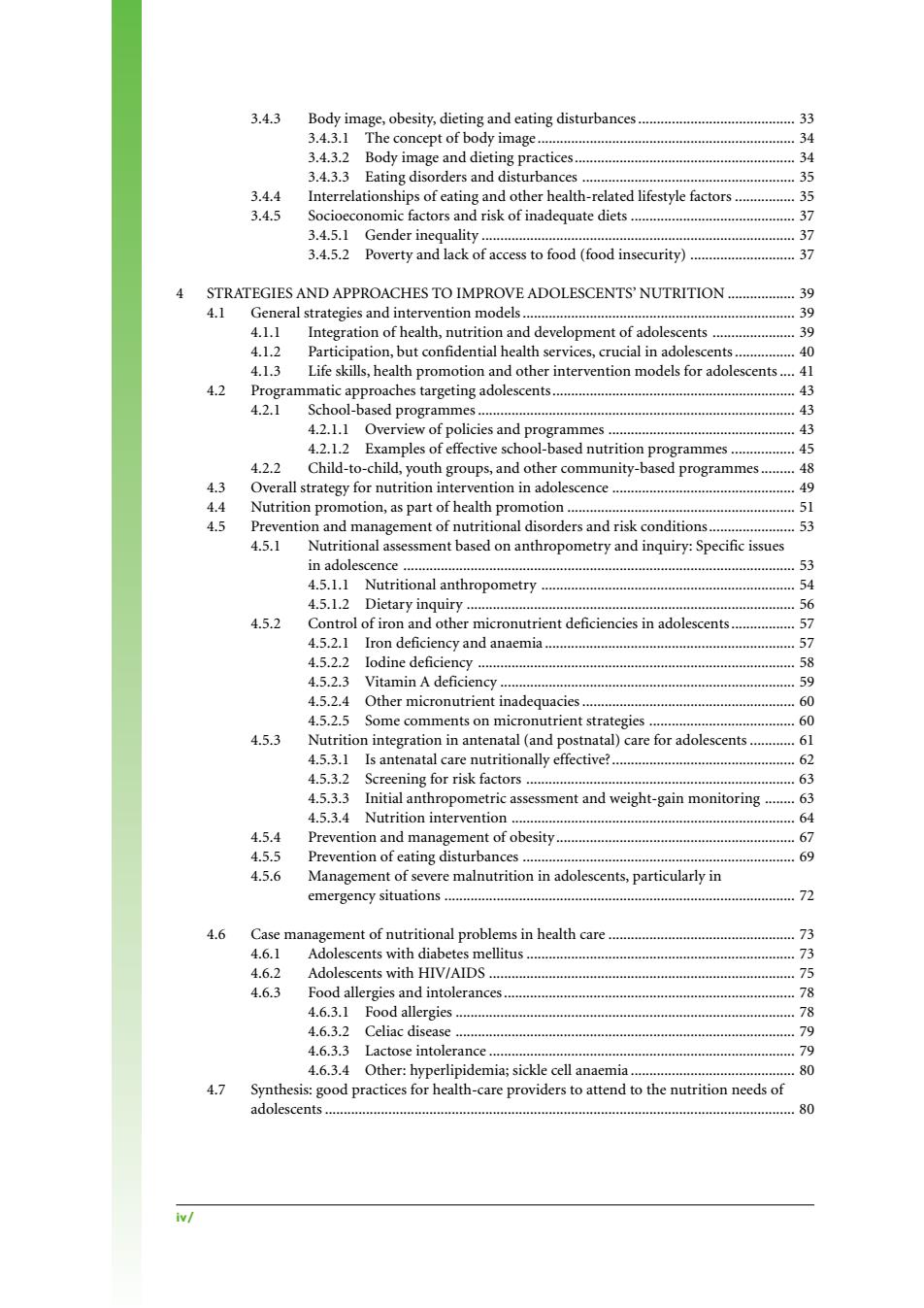正在加载图片...

3.4.3 Body image,obesity,dieting and eating disturbances........33 3.4.3.1 The concept of body image34 3.4.3.2 Body image and dieting practices...... 34 3.4.3.3 Eating disorders and disturbances ....... 35 3.4.4 Interrelationships of eating and other health-related lifestyle factors.35 3.4.5 Socioeconomic factors and risk of inadequate diets.37 3.4.5.1 Gender inequality 37 3.4.5.2 Poverty and lack of access to food (food insecurity)..... .37 4 STRATEGIES AND APPROACHES TO IMPROVE ADOLESCENTS'NUTRITION...................39 4.1 General strategies and intervention 4.1.1 Integration of health,nutrition and development of adolescents..... .39 4.1.2 Participation,but confidential health services,crucial in adolescents..............40 4.1.3 Life skills,health promotion and other intervention models for adolescents....41 4.2 Programmatic approaches targeting adolescents.43 4.2.1 School-based programmes 43 4.2.1.1 Overview of policies and programmes...............................43 4.2.1.2 Examples of effective school-based nutrition programmes ...............45 4.2.2 Child-to-child,youth groups,and other community-based programmes........48 4.3 Overall strategy for nutrition intervention in adolescence 49 4.4 Nutrition promotion,as part of health promotion......... 51 4.5 Prevention and management of nutritional disorders and risk conditions...................53 4.5.1 Nutritional assessment based on anthropometry and inquiry:Specific issues in adolescence53 4.5.1.1 Nutritional anthropometry. 54 4.5.1.2 Dietary inquiry... 56 4.5.2 Control of iron and other micronutrient deficiencies in adolescents................. 57 4.5.2.1 Iron deficiency and anaemia .57 4.5.2.2 Iodine deficiency. 58 4.5.2.3 Vitamin A deficiency 59 4.5.2.4 Other micronutrient inadequacies...... 60 4.5.2.5 Some comments on micronutrient strategies 60 4.5.3 Nutrition integration in antenatal (and postnatal)care for adolescents.............61 4.5.3.1 Is antenatal care nutritionally effective?. 62 4.5.3.2 Screening for risk factors........... .63 4.5.3.3 Initial anthropometric assessment and weight-gain monitoring.......63 4.5.3.4 Nutrition intervention. …64 4.5.4 Prevention and management of obesity67 4.5.5 Prevention of eating disturbances.. …69 4.5.6 Management of severe malnutrition in adolescents,particularly in emergency 4.6 Case management of nutritional problems in health care.......73 4.6.1 Adolescents with diabetes mellitus 73 4.6.2 Adolescents with HIV/AIDS5 4.6.3 Food allergies and intolerances8 4.6.3.1 Food allergies 78 4.6.3.2 Celiac disease 79 4.6.3.3 Lactose intolerance.............. .79 4.6.3.4 Other:hyperlipidemia;sickle cell anaemia 80 4.7 Synthesis:good practices for health-care providers to attend to the nutrition needs of adolescents.8 iv/iv/ 3.4.3 Body image, obesity, dieting and eating disturbances.......................................... 33 3.4.3.1 The concept of body image ..................................................................... 34 3.4.3.2 Body image and dieting practices........................................................... 34 3.4.3.3 Eating disorders and disturbances ......................................................... 35 3.4.4 Interrelationships of eating and other health-related lifestyle factors ................ 35 3.4.5 Socioeconomic factors and risk of inadequate diets ............................................ 37 3.4.5.1 Gender inequality .................................................................................... 37 3.4.5.2 Poverty and lack of access to food (food insecurity) ............................ 37 4 STRATEGIES AND APPROACHES TO IMPROVE ADOLESCENTS’ NUTRITION .................. 39 4.1 General strategies and intervention models......................................................................... 39 4.1.1 Integration of health, nutrition and development of adolescents ...................... 39 4.1.2 Participation, but confidential health services, crucial in adolescents ................ 40 4.1.3 Life skills, health promotion and other intervention models for adolescents .... 41 4.2 Programmatic approaches targeting adolescents................................................................. 43 4.2.1 School-based programmes..................................................................................... 43 4.2.1.1 Overview of policies and programmes .................................................. 43 4.2.1.2 Examples of effective school-based nutrition programmes ................. 45 4.2.2 Child-to-child, youth groups, and other community-based programmes ......... 48 4.3 Overall strategy for nutrition intervention in adolescence ................................................. 49 4.4 Nutrition promotion, as part of health promotion ............................................................. 51 4.5 Prevention and management of nutritional disorders and risk conditions....................... 53 4.5.1 Nutritional assessment based on anthropometry and inquiry: Specific issues in adolescence ......................................................................................................... 53 4.5.1.1 Nutritional anthropometry .................................................................... 54 4.5.1.2 Dietary inquiry ........................................................................................ 56 4.5.2 Control of iron and other micronutrient deficiencies in adolescents................. 57 4.5.2.1 Iron deficiency and anaemia ................................................................... 57 4.5.2.2 Iodine deficiency ..................................................................................... 58 4.5.2.3 Vitamin A deficiency ............................................................................... 59 4.5.2.4 Other micronutrient inadequacies......................................................... 60 4.5.2.5 Some comments on micronutrient strategies ....................................... 60 4.5.3 Nutrition integration in antenatal (and postnatal) care for adolescents ............ 61 4.5.3.1 Is antenatal care nutritionally effective?................................................. 62 4.5.3.2 Screening for risk factors ........................................................................ 63 4.5.3.3 Initial anthropometric assessment and weight-gain monitoring ........ 63 4.5.3.4 Nutrition intervention ............................................................................ 64 4.5.4 Prevention and management of obesity................................................................ 67 4.5.5 Prevention of eating disturbances ......................................................................... 69 4.5.6 Management of severe malnutrition in adolescents, particularly in emergency situations .............................................................................................. 72 4.6 Case management of nutritional problems in health care .................................................. 73 4.6.1 Adolescents with diabetes mellitus ........................................................................ 73 4.6.2 Adolescents with HIV/AIDS .................................................................................. 75 4.6.3 Food allergies and intolerances .............................................................................. 78 4.6.3.1 Food allergies ........................................................................................... 78 4.6.3.2 Celiac disease ........................................................................................... 79 4.6.3.3 Lactose intolerance .................................................................................. 79 4.6.3.4 Other: hyperlipidemia; sickle cell anaemia ............................................ 80 4.7 Synthesis: good practices for health-care providers to attend to the nutrition needs of adolescents .............................................................................................................................. 80